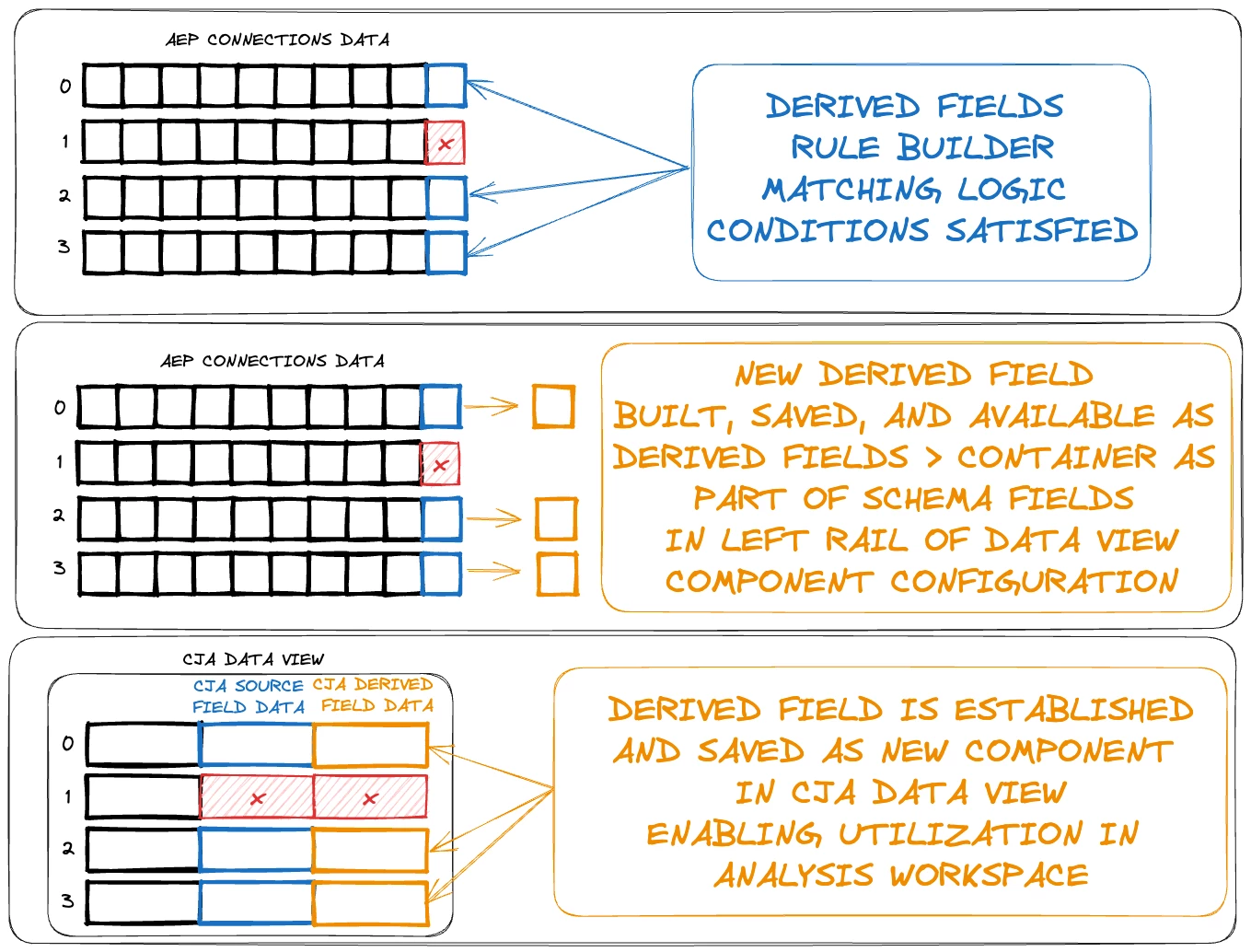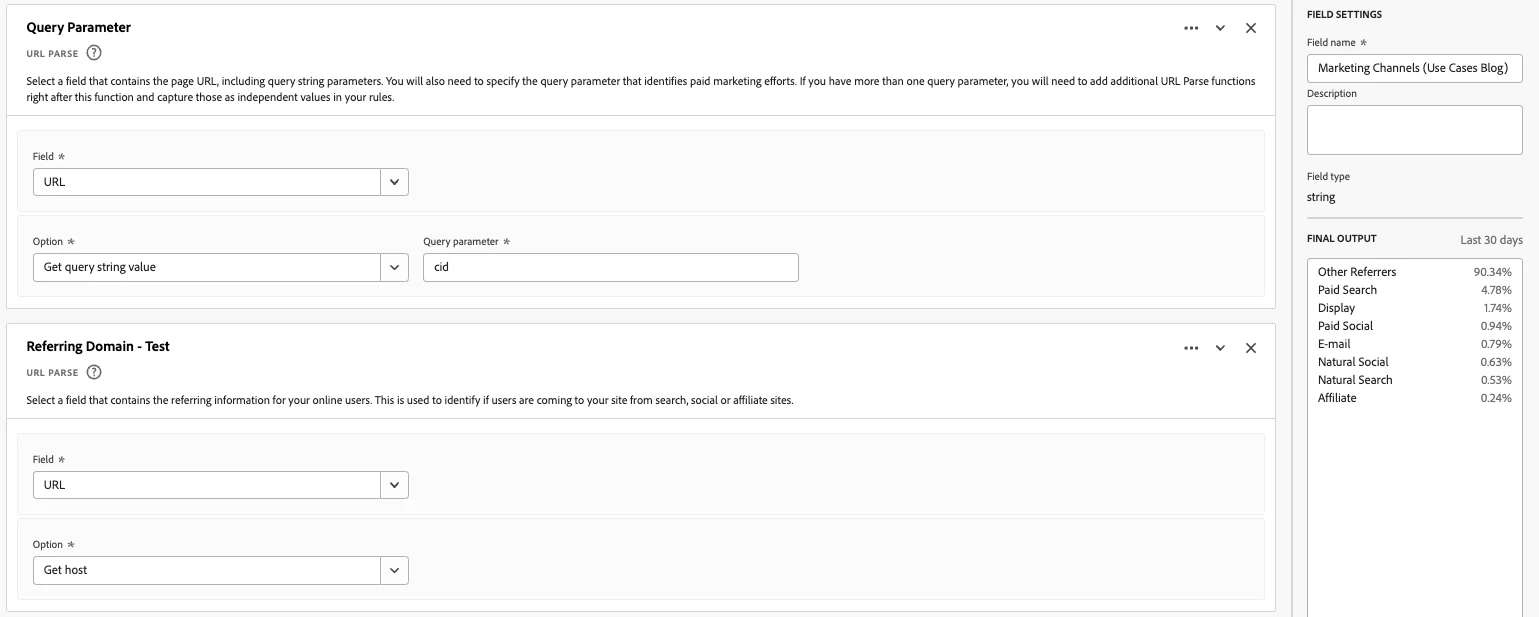Derived Fields Use Cases for Customer Journey Analytics
Introduction
Derived fields is a powerful new feature of Customer Journey Analytics (CJA). It allows users to transform their CJA schema fields at the Connections-level in various ways. Using the derived fields interface, users can instantly and retroactively make non-destructive derivations to their CJA dataset fields. This can potentially save time and effort by avoiding data rework and reprocessing, while enhancing the quality of the end CJA Data View data. As a result, it leads to faster time to business value and insights.
The CJA derived fields feature empowers users to perform more accurate and insightful analyses, leading to better business decisions and outcomes. By providing CJA administrators with the ability to manipulate their CJA Data Views in ways that were previously not possible, this feature is an invaluable tool to maximize the potential of already captured data and uncover insights that can drive business success.
June 2024 Update: Review of Derived Fields Enhancements in Adobe Customer Journey Analytics Derived Fields Enhancements
How Derived Fields Logic Works in CJA
Derived fields in CJA are closely related to the process of configuring a data view's schema component settings. They allow you to create new components sourced from existing fields by basing them on those fields. This can be useful when you need to work with manipulated data in ways that are not possible with the existing fields.
The diagram below outlines the conceptual process that governs derived fields and the finishing process to enable their utilization within a CJA Data View.

One of the key benefits of derived fields is their ability to logically operate against the same dataset connection-level data assets as manifested on an ingested row field or a prior established derived field rule basis. This means you can use derived fields to perform supported function manipulations on any data already present in your dataset. Derived fields logic spans the available CJA standard fields, custom schema fields, or any prior established derived field rules. This allows you to create derived fields based on a wide variety of different data assets depending on your needs.
It's important to keep in mind that the creation of derived fields is limited by the data present in the field schema on a row-by-row basis. This means that derived fields can only operate logically on the string or numeric values explicitly present in the schema during the creation process, using the derived field rule builder. By carefully examining the data and using creative problem-solving techniques, you can often find ways to create derived fields that provide valuable and additive insights into the underlying data.
Contextually, it's important to note that derived field rules have no awareness of same person-level or session-level boundaries, as is available in the CJA Filters segmentation functionality. Therefore, use caution when using derived fields and ensure that you are manipulating data appropriately for your specific derivative use cases. Additionally, derived fields cannot yet be used with lookup and profile fields, although this functionality is planned for a future product release.
Derived Fields Use Cases
- Marketing Channels Instantiation: In a CJA fashion, derived fields can replicate the Adobe Analytics Marketing Channels processing rules. By following the configuration steps outlined in the Marketing Channels template, users can use the Url Parse and Case When functions to identify inbound traffic sources based on URL, referring domain, and query parameter permutations.
With CJA's retroactive and query-run time capabilities, users can adjust and fine-tune rule logic over time without missing any marketing channels or sources of traffic. This ensures that all marketing channels are accurately captured and provides a comprehensive understanding of how users interact with platforms and where they come from. Derived fields can help businesses make more informed decisions when optimizing their marketing strategies and driving paid, earned, and owned growth.

- Friendly Name Component Mappings: When a component's set values in CJA does not have a user-friendly or understandable reference, you can use the derived fields functionality to rename values into a new dimension. This can be a quick win with less overhead than managing via ingested lookups for small cardinality subsets of values in CJA. In the example below, using the standard field of Platform Dataset ID, derived fields allow for any custom string value friendly name identifier to be additively set as a component dimension. It is worth noting that this approach not only simplifies the management of CJA, but also enhances the user experience by allowing for more intuitive naming conventions. Additionally, by utilizing derived fields, users can more easily identify and understand the values being presented, which can lead to better decision-making and a more efficient workflow. Therefore, incorporating derived fields into your CJA strategy can be a valuable tool for improving both the management and user experience of your analytics data.

- Cross-Dimension Unified Component Mappings: If you are looking to expand your data analysis capabilities, the Concatenate function provided by the derived fields functionality may be of use to you. This function allows you to combine values across dimensions into a single combined value for more comprehensive insights. For instance, you can easily join the 'Customer Relationship' signifier indicator with user-determined delimiting, and append all corresponding 'Customer Tier' values. By creating new dimension variations using the data already collected in the CJA Connection, you can gain a deeper understanding of your data and uncover new insights that may have previously gone unnoticed.

- Dimension Values Refinement: The Find & Replace functionality of derived fields is an incredibly useful tool that can help you easily and quickly deal with rogue or malformed values within a dimension. By using this feature, you can identify and replace problematic values that may be causing issues with data aggregation or that are otherwise causing problems, ensuring that your data is accurate and symmetrical across all value variations. Additionally, the Find & Replace functionality can help streamline your data analysis processes, saving you time and effort while ensuring that you're making informed decisions based on accurate and reliable data. With this feature, you can be confident in the quality and accuracy of your data, allowing you to focus on generating insights and driving better business outcomes.

- Custom Date Ranges: Derived fields are a useful tool for working with CJA Standard Fields for time references. They allow you to create custom dimensions that are tied to specific custom date range criteria. Using derived fields, you can also specify all other time periods, giving you more flexibility when analyzing your data. In addition, derived fields can indicate specific date ranges that adhere to non-standard date parsing conventions. This includes date ranges with gaps that still need to be linked to aggregate. This enables you to better understand the relationships between different data points across time bounds and gain deeper insights into your data.

Conclusion
This blog post explores various use cases for implementing derived fields in Customer Journey Analytics (CJA). By using derived fields, organizations can greatly enhance data quality and overall usability, resulting in reduced inconsistencies in CJA data interpretation and analysis. The power of derived fields lies in their ability to create entirely new component derivations, which can offer invaluable insights from the data already captured.
In addition to the information presented in this blog post, there are additional resources available to help you fully understand the potential of derived fields. You can check out the Derived Fields Experience League Documentation to learn more about the functional aspects of implementing derived fields. Additionally, the Derived Fields Video on Experience League provides a walkthrough demonstration of derived fields. By using derived fields, your business can fully unlock the potential of the data you collect.



